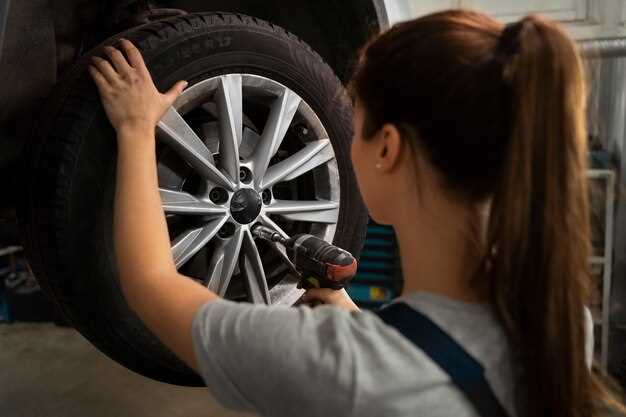
Improving your vehicle’s handling is a crucial aspect of enhancing its overall performance. One of the most effective ways to achieve this is by upgrading to performance tires. These specialized tires are designed to provide superior grip, responsiveness, and stability compared to standard options, making them an excellent choice for both everyday driving and spirited performance.
When it comes to the handling characteristics of your car, the tires play a pivotal role. Performance tires are engineered with advanced tread patterns and rubber compounds that optimize traction on various road surfaces. By investing in these tires, you’re not just enhancing your vehicle’s aesthetics but significantly improving its ability to corner, accelerate, and brake effectively.
Furthermore, the right set of performance tires can transform your driving experience. Whether tackling winding mountain roads or navigating city streets, the increased control and feedback they offer can lead to heightened confidence behind the wheel. In this article, we will explore the various benefits of performance tires and how they can contribute to better handling, making your driving experience safer and more enjoyable.
Understanding the Benefits of Performance Tires for Your Vehicle
Performance tires are designed to enhance the driving experience by providing superior grip and handling. One of the primary benefits of these tires is improved traction in both dry and wet conditions. Their specialized tread patterns and rubber compounds are optimized to deliver maximum contact with the road, which translates into better acceleration, cornering, and braking capabilities.
Another significant advantage is increased responsiveness. Performance tires often feature a stiffer sidewall construction, which reduces flex during high-speed maneuvers. This rigidity allows for quicker steering response, giving drivers greater control over their vehicle in dynamic driving situations. Whether navigating sharp turns or merging onto highways, performance tires make the driving experience more engaging and predictable.
Additionally, performance tires contribute to improved braking distances. Enhanced grip not only aids in acceleration but also ensures shorter stopping distances due to better friction with the road surface. This is particularly critical in emergency situations where quick stops can be the difference between safety and an accident.
Moreover, many performance tires are engineered to provide better feedback to the driver. This means that road feel and handling characteristics are more pronounced, enabling drivers to make informed adjustments based on the vehicle’s behavior. Enhanced feedback creates a more connected driving experience, allowing enthusiasts to better exploit their vehicle’s potential.
Lastly, performance tires can elevate the aesthetic appeal of your vehicle. With a wider profile and aggressive tread designs, they can significantly enhance the overall look of your car, making it appear sportier and more dynamic. This visual upgrade often complements the performance enhancements, making both your vehicle’s handling and its styling more appealing.
Key Features to Look for in Performance Tires
When selecting performance tires for your vehicle, it’s essential to consider several key features that will enhance handling, grip, and overall driving experience. Here are the primary features to evaluate:
- Tread Design: Look for an aggressive tread pattern designed to maximize grip on both wet and dry surfaces. Directional and asymmetric treads often provide better stability and cornering performance.
- Tire Composition: Performance tires typically use softer rubber compounds that offer improved traction. Consider high-grip compounds that enhance performance but may wear out faster than standard tires.
- Temperature Resistance: High-performance tires should perform well at various temperatures. Look for tires designed to maintain grip and avoid inconsistency, especially during extreme conditions.
- Sidewall Stiffness: A stiffer sidewall can improve handling by reducing flex during cornering. This feature contributes to precise steering response and better control.
- Tire Size: Ensure the size matches your vehicle’s specifications and desired handling characteristics. Wider tires can enhance grip but may also affect ride comfort and fuel efficiency.
- Performance Ratings: Review the tire’s speed and load ratings, which indicate how well the tire performs under different conditions. Higher ratings generally reflect better performance capabilities.
- Wear Resistance: While performance tires may sacrifice some longevity for grip, look for those that offer a balanced compromise between traction and durability.
- Noise Levels: Assess the noise generated by the tires. Some high-performance tires can be noisier than standard tires, so it’s advisable to consider those designed for a quieter ride.
- Brand Reputation: Research reputable brands known for quality performance tires. Consumer reviews and expert recommendations can guide you to reliable options that suit your needs.
By focusing on these key features, you can make an informed decision when upgrading to performance tires, ultimately improving the handling and performance of your vehicle.
How to Choose the Right Performance Tires for Your Driving Style

Choosing the appropriate performance tires begins with understanding your driving habits and the conditions you typically encounter. Assess whether you primarily drive on the street, engage in track racing, or participate in both. Street performance tires often emphasize comfort and longevity, while track tires focus on maximizing grip and responsiveness.
Next, consider the climate in your area. If you live in a region with significant rainfall or snow, performance tires designed for wet conditions or all-season options may be necessary. These tires have specialized tread patterns that enhance traction on slick surfaces. Conversely, if you drive in dry environments, tires with softer rubber compounds and optimized tread designs will provide superior performance and handling.
Evaluate your vehicle type and its intended use. High-performance sports cars benefit from ultra-high-performance tires that enhance cornering stability and precision. In contrast, daily drivers might prioritize a balance between sporty handling and ride comfort. Research tire specifications, such as tread wear ratings, performance characteristics, and load capacities, to ensure compatibility with your vehicle.
Your driving style also impacts tire selection. If aggressive cornering and rapid acceleration are part of your routine, seek tires with a wider contact patch and advanced tread technology. For those who prefer a more relaxed driving experience, tires that focus on comfort and noise reduction may be more suitable.
Finally, consult expert reviews and feedback from other drivers. Tire performance can vary significantly among brands and models, so researching user experiences provides valuable insight into how they will perform in real-world conditions. If possible, visit a tire retailer that allows you to discuss options with knowledgeable staff, ensuring you make an informed choice tailored to your driving needs.
Best Practices for Installing Performance Tires
Installing performance tires correctly is crucial for maximizing their benefits in handling, grip, and overall vehicle performance. Here are some best practices to ensure a successful installation.
Firstly, begin by selecting the right tires for your vehicle. Consult your vehicle’s manual or a professional to find tires that suit your car’s specifications, driving style, and road conditions. Performance tires can vary significantly based on tread patterns and rubber compounds, so choose ones that align with your intended use, whether it’s for street driving, track racing, or off-road adventures.
Next, gather all necessary tools and equipment before starting the installation process. Essential tools include a jack, jack stands, a torque wrench, tire irons, and bead lubricant. Ensure that your work area is clean, well-lit, and flat to facilitate a secure installation.
Once you have your tires and tools ready, lift the vehicle using a jack and secure it with jack stands. This ensures your safety during the installation. Remove the existing tires, taking care to keep track of the order they were removed, as this can affect the balance and handling of the vehicle if not replaced correctly.
Prepare the new tires by checking for any defects or imperfections before mounting. Apply bead lubricant to the edges of the tires to assist with fitting. Mount each tire onto the wheel, ensuring it aligns properly with the rim. Use a tire iron to tighten the lug nuts in a star pattern to ensure even pressure distribution.
After installing the tires, it is essential to torque the lug nuts to the manufacturer’s specifications. Over-tightening or under-tightening can lead to handling issues or wheel detachment. Use a torque wrench for accuracy, and double-check these specifications after a short drive to ensure they remain secure.
Finally, have your tires balanced and aligned by professionals. Proper alignment and balance will enhance handling, prolong tire life, and ensure an even distribution of wear. Regularly check tire pressure in accordance with manufacturer recommendations, as performance tires can be sensitive to pressure fluctuations.
Tips for Maintaining Your Performance Tires
Maintaining performance tires is essential for ensuring optimal handling, safety, and longevity. Here are some key tips to keep your tires in top condition:
1. Regular Pressure Checks: Monitor tire pressure at least once a month and before long trips. Performance tires typically require higher pressure than standard tires, so refer to the manufacturer’s specifications. Proper inflation improves grip and fuel efficiency.
2. Rotate Tires Frequently: To ensure even wear, rotate your tires every 5,000 to 7,500 miles. This practice can extend the lifespan of your performance tires and maintain their handling capabilities.
3. Align and Balance: Have your tires aligned and balanced regularly to prevent uneven wear. Misalignment affects steering accuracy and can lead to premature tire wear. Professional services can adjust camber, toe, and caster to align your tires properly.
4. Inspect for Damage: Regularly check your tires for cracks, cuts, or bulges. These defects can compromise performance and safety. If you find any damage, consult a tire professional to determine if the tire needs repair or replacement.
5. Clean the Tires: Keep your tires clean by removing dirt, debris, and brake dust. Use a gentle soap and brush to avoid damaging the rubber. Cleaning helps maintain the tire’s appearance and performance characteristics.
6. Monitor Wear Patterns: Watch for uneven wear patterns, which can indicate alignment issues or incorrect inflation. Identifying these signs early can help you address problems before they lead to significant tire damage.
7. Store Properly: If you need to store your performance tires, keep them in a cool, dark, and dry location. Avoid exposing them to extreme temperatures and sunlight, as this can weaken the rubber compound and affect performance.
By following these tips, you can enhance the performance, safety, and longevity of your performance tires, ensuring a better driving experience.
Assessing the Impact of Performance Tires on Fuel Efficiency
When considering the upgrade to performance tires, many drivers are primarily focused on improved handling and traction. However, it is essential to evaluate how these tires influence fuel efficiency as well. Performance tires are designed with specialized tread patterns and rubber compounds that enhance road grip and cornering abilities. While these features can significantly improve the driving experience, they may also lead to changes in fuel consumption.
One of the key factors affecting fuel efficiency is the rolling resistance of the tires. Performance tires typically have lower rolling resistance compared to standard tires, especially when optimized for highway driving. This reduction means that less energy is required to maintain speed, which can lead to better fuel economy. Nonetheless, the trade-off is that these tires often feature softer compounds, which may wear faster and potentially affect long-term costs.
A crucial aspect to understand is the relationship between tire pressure and fuel efficiency. Performance tires may require more precise inflation levels for optimal performance. Under-inflated tires can significantly increase rolling resistance, leading to reduced fuel efficiency. Maintaining the correct tire pressure not only ensures better handling but can also maximize the potential fuel savings associated with performance tires.
Driving habits also play a vital role in determining the overall impact of performance tires on fuel economy. Aggressive driving, characterized by rapid acceleration and hard braking, can negate the benefits of performance tires. A smoother driving style, combined with performance-oriented tires, can yield substantial fuel savings along with enhanced handling and responsiveness.
In summary, while performance tires can positively influence fuel efficiency under the right conditions, factors such as rolling resistance, tire pressure, and driving habits must be considered. By balancing these elements, drivers can enjoy the performance benefits without compromising fuel economy.














